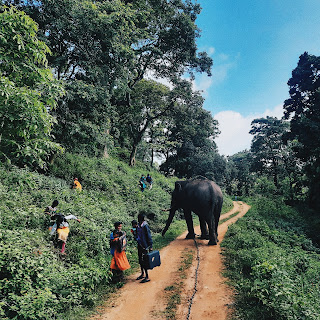Two plants and Khwünora
We were on our daily morning bird-walk, Ano Angulie and I, sharing stories and experiences. I pointed to a tree that had caught my eye since I first saw it, one that I distinctly remembered from my previous trip to Khonoma. To me, it looked fascinating but unfamiliar - alien almost; as if it had been uprooted and replanted a couple of metres above the ground, with its roots still clinging to a lump of soil forming its new base. A few feet above the ground, thin branches with small leaves sprouted out of this earthy base. Climbers coiled up its trunk, green and alive or dead and golden. "This is the Alder tree," Ano Angulie said, "It is what has kept this forest alive." Downhill from this point, he explained, the entire area was being used for shifting cultivation.
 |
| Fields or plantations of Nepalese alder (Alnus nepalensis) look mystical in the hills overlooking Khonoma. |
The Nepalese alder (Alnus nepalensis) is a semi-deciduous tree found across the Himalayas, Pakistan, Nepal, Myanmar, North and North East India, and Bhutan. It is an important part of indigenous agro-forestry systems of several tribes in Nagaland - like the Angami, Chang, Chakhesang, Konyak, and Yimkhiung. Alder is an intercrop with paddy, tapioca, turmeric, colocasia, and more. A symbiotic relationship between the Alder and a nitrogen-fixing bacteria from the genus Frankia allows it to be highly beneficial as a an intercrop. This also makes possible productive cycles of jhum cultivation, regenerating nutrients in the soil.
Primary and secondary crops are intermixed and grown with the trees in the first and second year, following which the field is left fallow for three years to let the alder trees grow. When the tree grows to a height of about 2 metres, it is pollarded - the branches are cut, leaving the main trunk intact. The remaining trunk is covered with mud and straws to prevent drying - this is why the bulging base and thin branches that you can see in the pictures. The base is much older than the branches; and the layers of mud and soil symbolise years of indigenous botanical wisdom birthing a new kind of life to this fascinating tree.
 |
| The base of the Alder tree here would usually be much older than its branches. |
Later that day, we crossed the hill overlooking the village towards Dzüleke. This is where I would learn about the second, lesser-known story of another plant linked to Khonoma. I had just learnt that Dzüleke meant "where the water disappears", for here, the Dzülerütie river "disappears" under rocks and stone and continues to flow ahead. "Does Khonoma also have a meaning?" I asked Ano Angulie. "Yes, but..." he paused, "Khonoma, Kohima: these are all names given by the British, because they couldn't pronounce our local village names in Tenyidie (the language of the Angami Naga)." It was then that I learnt with great surprise that Khonoma, was in fact, originally called Khwünora (the pronunciation of “khwü” is somewhere between “kha” and “pha”; I initially even mistook the name to be “Phunore”)! "Khwünora comes from the name of a plant called Khwüno. It is found all around the village and its forests. I'll show you." A bit ahead, Ano Angulie pointed to a small plant growing on the side of the road from the edge of a *cliff*. With a dark pink stem and green oval-shaped leaves, it looked pretty "normal"; certainly not a plant I would have noticed on my own or stopped for to get a better look. "This is khwüno," he told me, “This is the plant that Khonoma - or Khwünora - was named after." He plucked a small stem with four to five leaves, "When we get back home, I'll show you something."
 |
| This small plant - khwüno - looks nothing special. But it is extremely significant to the famous village of Khonoma - it is the origin behind its name! |
Back in Ani Atsi’s kitchen, we sat around the fireplace. Ano Angulie took the plant towards the flames, and holding one end of the stem, started to burn the leaves. CRACK! I jumped. The burning leaves were producing a cracking, popping sound, with little sparks scattering around the stem. Ano Angulie continued to gently push the entire stem into the flames, and I continued to be amazed at the resulting sound – reminiscent of ladi-like firecrackers I was used to, only much less annoying.
 |
| Sparks fly and and the kitchen fills with popping sounds as Ano Angulie burns khwüno. |
It reminded me of another story I had heard about Khonoma from my guide Martin: when the British tried to occupy and take control of Khonoma, the villagers escaped to the hills. While the British troops prepared to face them on their inevitable return, they started hearing loud sounds of ammunition from the hills. They believed that the villagers had hidden loads of ammunitions in the hills, causing significant anxiety among the foreign invaders. Little did they know, the Khonoma villagers were actually burning bamboo in the hill forests - bamboo when burnt produces loud exploding sounds that sound quite similar to ammunition. This happens because a great amount of air is trapped inside the stalks of the plant, which bursts with a loud popping sound when heated and compressed.
Contrary to my expectation, khwüno is not used for food or rituals. With the original name of the village, khwüno stands to become invisible to most of us.
A special thank you to Angulie Meyase for sharing the wonderful stories and knowlege about these plants.


Comments
Post a Comment